PANASONIC NR-BN34EX1, NR-BN34EX1-E User Manual
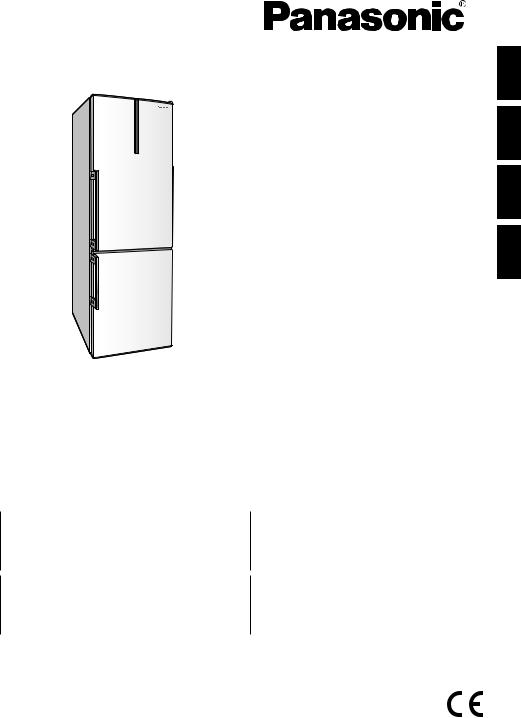
Operating Instructions
Refrigerator-Freezer
(Household use)
Model No. NR-BN34EX1
Français Nederlands Deutsch English
English |
2-18 |
Thank you for purchasing this Panasonic product. |
|
Please read these instructions carefully before using this |
|
product. Please keep this manual for future reference. |
|
Included installation Instructions. |
|
Nederlands |
36-52 |
Hartelijk dank voor uw aankoop van dit Panasonic product. Lees deze aanwijzingen aandachtig door voordat u dit product in gebruik neemt. Bewaar deze handleiding voor latere naslag. Inclusief installatiehandleiding.
Deutsch |
19-35 |
Wir danken Ihnen für den Kauf dieses Panasonic-Produkts. |
|
Bitte lesen Sie dieseAnweisungen vor der Benutzung dieses |
|
Produkts sorgfältig durch. Bitte bewahren Sie dieseAnleitung für |
|
spätere Bezugnahme auf. Installationsanleitung enthalten. |
|
Français |
53-69 |
Nous vous remercions d’avoir acheté un produit Panasonic. Veuillez lire ce mode d’emploi attentivement avant d’utiliser ce produit.Prièredeconservercemoded’emploipourtouteréférence ultérieure. Instructions d’installation incluses.
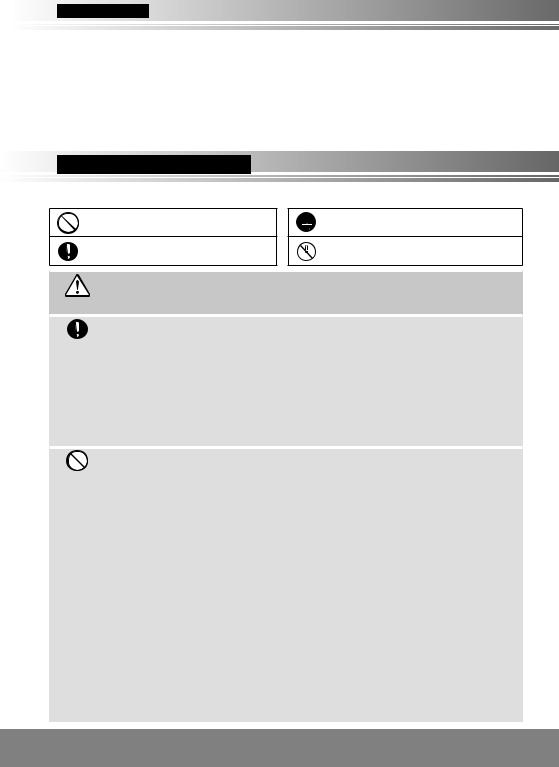
 Contents
Contents
Safety instructions 2 Caring for the environment 5 Installation 6 Parts 8 Control panel 9 Setting the temperature 10 Using the handy functions 10
Humidity control of “Vitamin Safe” Crisper 13 Making ice cubes 13 Removing and attaching shelves 13 Care and Cleaning instructions 14 FAQs 16 Specifications 18
 Safety instructions
Safety instructions
What the symbols mean:
Do not
Make sure you do this
Indicates the appliance must be earthed to prevent electric shock
Do not take apart
WARNING Indicates risk of death or serious injury.
This appliance can be used by children aged from 8 years and
above and persons with reduced physical, sensory or mental capabilities or lack of experience and knowledge if they have been given supervision or instruction concerning use of the appliance in a safe way and understand the hazards involved. Children shall not play with the appliance. Cleaning and user maintenance shall not be made by children without supervision.
Do not store explosive substances such as aerosol cans with a flammable propellant in this appliance.
•Flammable substances such as benzene, thinners, alcohol, ether and Liquid Petroleum Gas (LPG) can cause explosions.
Do not use a multiple socket adaptor and plug several appliances into the same socket adaptor.
• This can cause overheating, fire or short circuit.
Do not pinch, knot, or bend the mains lead, or place heavy objects on it.
•This increases the risk of fire or electric shock. If the mains lead or plug of the appliance is damaged, it must be replaced by the manufacturer, its service agent or similarly qualified person in order to avoid a hazard.
Do not unplug the refrigerator by pulling on the mains lead.
• This can damage to the mains lead.Always grip the mains plug and pull firmly from the socket.
Do not place any water container on the top of the refrigerator.
• Water can damage insulation of electrical components and cause short circuit, fire or electric shock.
Do not spray inflammable gas near the refrigerator.
• This can cause explosion or fire.
Do not spray water onto or into the refrigerator.
• This can cause fire or electric shock.
Do not touch the mains plug with wet hands.
• This can cause electric shock.
2
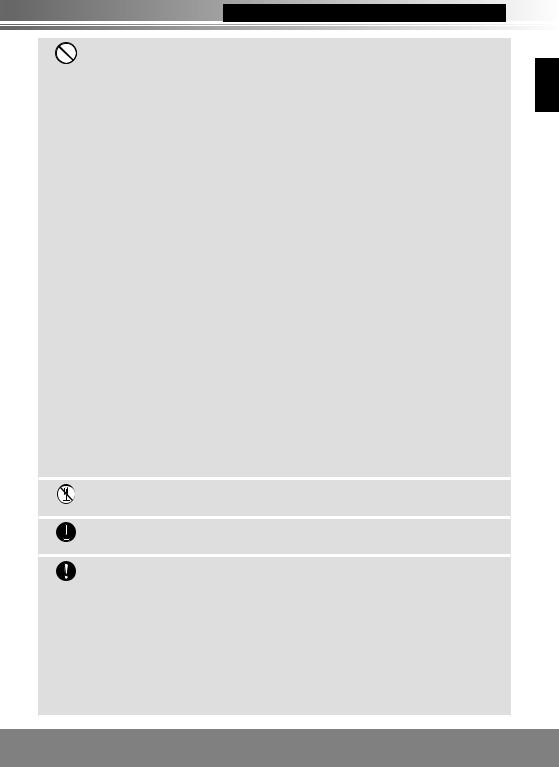
Safety instructions (continued) 
Do not install the refrigerator in a damp place, or where it may come into contact with water.
• Deteriorated insulation of electrical parts can cause short circuit, electric shock or fire.
Do not store pharmaceuticals or other temperature-sensitive products in the refrigerator.
• You should not store products that require strict temperature controls in the refrigerator.
Do not let children climb, swing or hang on the refrigerator door.
• This can cause serious injury, as well as damaging the refrigerator.
Do not operate the refrigerator in the presence of explosive fumes or flammable gas.
• This can cause explosion or fire.
Do not store petrol or other flammable liquids and vapours in the refrigerator, or use them near the appliance.
• This can cause explosion or fire.
-WARNING: Do not use mechanical devices or other means to accelerate the defrosting process, other than those recommended by the manufacturer.
•This can cause damage to the interior of the refrigerator or cause an explosion.
-WARNING: Do not use electrical appliances inside the food storage compartments of the appliance, unless they are of the type recommended by the manufacturer.
• This can cause explosion or fire.
-WARNING: Do not damage the refrigerant circuit.
• This can cause explosion or fire.
-WARNING: Do not open the cover of LED lighting of fridge interior.
•This can cause electric shock. If the LED lighting does not work correctly, it must be replaced by the manufacturer, its service agent or similarly qualified person in order to avoid a hazard.
Do not try to disassemble, repair or modify the refrigerator yourself.
•You may injure yourself – or others – with burns or electric shock, or damage the refrigerator. If your appliance needs alterations or repair, please consult authorized service centre.
Ensure that the refrigerator is plugged into an earthed mains socket. DO NOT plug into an unearthed mains socket.
• Ashort circuit could cause an electrical shock.
Make sure the mains lead and plug are not squashed or damaged.
•Adamaged mains plug or lead can cause short-circuit, fire or electric shock.
•If the mains lead is damaged, it must be replaced by the manufacturer, its service agent or similarly qualified persons in order to avoid a hazard.
•Do not attempt to replace it yourself.
English
3
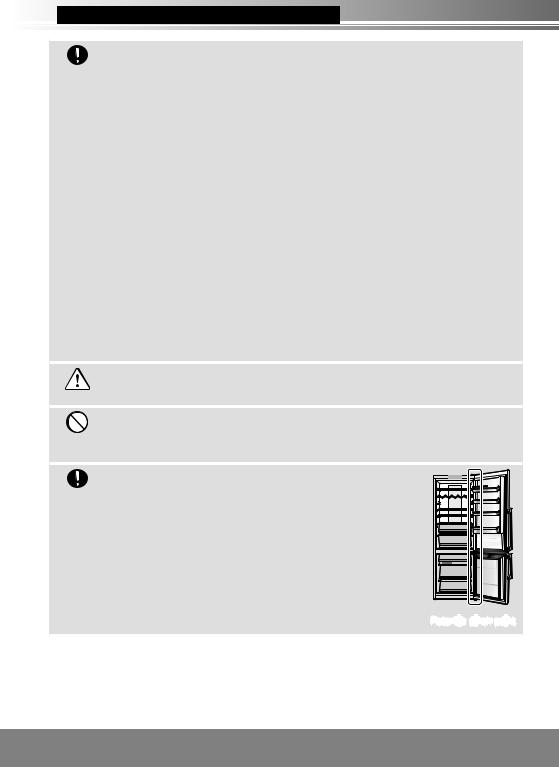
 Safety instructions (continued)
Safety instructions (continued)
Remove any dirt or dust from the mains plug’s pins before connecting to the power supply.
• Dust build-up on the mains plug can cause insulation failure, especially in humid conditions. This can cause short circuit, fire or electric shock. Unplug the mains lead and wipe it with a dry cloth. Never use a wet or damp cloth.
Plug your appliance into the socket, making sure the connection is secure.
• Aloosely connected mains plug can cause fire or electric shock.
Install the refrigerator in a well-ventilated area.
•The more refrigerant there is in an appliance, the larger the room it should be installed in. If there’s a refrigerant fluid leak, and the appliance is in a small room, the build up of combustible gases is more likely. This can cause fire or explosion.As a guide, for every 8 g of coolant, you’ll need at least 1 cubic metre of space in the room. The data plate inside the appliance tells you how much refrigerant your refrigerator contains.
The refrigerant (R600a) used in the refrigerator and the gases in the insulation material (cyclopentane) are both flammable. They also require special disposal procedures.
•Before you dispose of the appliance, make sure none of the pipes on the back are damaged. Refrigerant or gas leaks can cause fire or explosion.
Unplug the refrigerator before cleaning and servicing.
• Failure to do this can cause electric shock.
If you smell burning or see smoke coming from the refrigerator, disconnect the power immediately and please consult authorized service centre.
• Failure to do this can cause fire or electric shock.
-WARNING: Keep ventilation openings, in the appliance enclosure or in the built-in structure, clear of obstruction.
•Failure to do this could result in fire or explosion because refrigerant cannot disperse if it leaks.
CAUTION Indicates risk of injury or damage to property.
Do not put glass bottles or containers in the freezer.
• When the contents freeze, the glass may break and cause injury.
Do not touch the inside walls of the freezer or items stored in the freezer with wet hands.
• Your skin can become frozen onto the interior wall, or items stored in the freezer.
If there’s a power cut, avoid opening the refrigerator frequently or putting unchilled food in it.
• This can cause the temperature in the refrigerator to rise and adversely affect sanitation.
Also, be careful of the gap between the fridge and freezer doors, especially if they are both open at the same time.
• This may cause personal injury.
When opening the refrigerator, be careful not to pinch your fingers at the “pinch point” areas. In particular, when opening the fridge door, be careful to avoid the potential pinch point between the fridge and freezer doors.
• This can cause personal injury.
Potential pinch point
pinch point
4
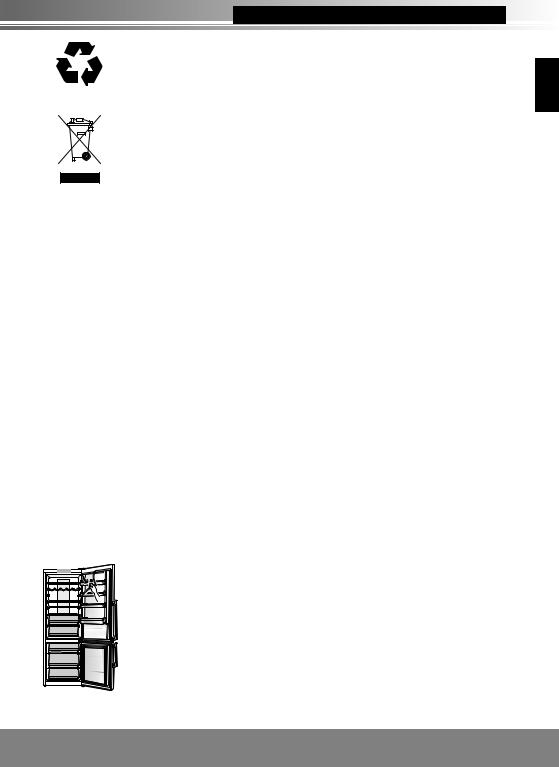
Caring for the environment 
Disposing of the packaging
Please recycle where possible (e.g. cardboard, plastic bags, adhesive tape and polystyrene) and make sure you dispose of all other packing materials safely.
Keep the packaging out of the reach of babies and young children, to avoid injury or suffocation.
Disposal of Old Equipment
Only for European Union and countries with recycling systems
This symbol on the products, packaging, and/or accompanying documents means that used electrical and electronic products must not be mixed with general household waste.
For proper treatment, recovery and recycling of old products, please take them to applicable collection points in accordance with your national legislation.
By disposing of them correctly, you will help to save valuable resources and prevent any potential negative effects on human health and the environment. For more information about collection and recycling, please contact your local municipality. Penalties may be applicable for incorrect disposal of this waste, in accordance with national legislation.
For business users in the European Union
If you wish to discard electrical and electronic equipment, please contact your dealer or supplier for further information.
Information on Disposal in other Countries outside the European Union
This symbol is only valid in the European Union.
If you wish to discard this product, please contact your local authorities or dealer and ask for the correct method of disposal.
English
Before disposing of your old appliance
Please follow either the disposal instructions from the manufacturer of the old appliance, or local disposal regulations for the appliance. Where this is not available, please follow the three step instructions below.
1.Remove the mains plug from the socket.
2.Cut the mains lead off, and safely dispose of it with the mains plug still attached.
3.Until the old appliance is collected, or you take it to a Recycling Centre, make sure it’s out the reach of small children.
●Remove all sealing materials from the door and leave all the shelves and drawers in place. This way, children are less likely to climb in and become trapped.
5
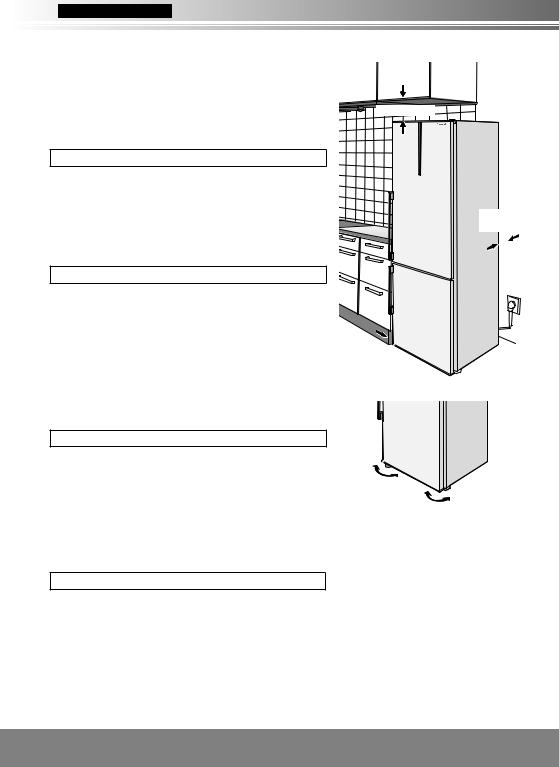
 Installation
Installation
This section explains how to install your appliance for the most energy-efficient, safe and quiet operation.
Dimensions
W600 x D633 x H2000 (mm)
Unpacking your appliance
Remove all packaging and tape.
Choosing the right location
Ventilation
As the appliance gives off heat during operation, it should be installed in a well-ventilated, dry room with plenty of space above and behind it, as shown in Figure 1.
If you can hear it vibrating, it needs more space.
(However, if there is a wall on the side of the refrigerator, a space of 32.5 mm or more is required on the hinge side for the doors to open 90° or more.)
Temperature
The room temperature affects the refrigerator’s energy-efficiency, i.e.
how much electricity it uses to chill and freeze foods. For the best results, install your refrigerator:
●away from direct sunlight
●away from radiators, cookers or other heat sources
●where the room temperature corresponds to the climate classification for which the appliance is designed. Refer to the Specifications Section for your appliance’s climate classification.
●Extreme temperatures or environmental conditions may have negative impact on its performance.
Stored food may spoil.
Level
After carefully positioning the appliance so as not to damage floor surfaces, install on a level floor that’s strong enough to support a fully loaded refrigerator.
You can adjust the level of the refrigerator by screwing or unscrewing the two adjustable legs as shown in Figure 2.
This prevents vibration and noise.
If the appliance is to stand on a carpeted or vinyl floor, put a solid board underneath it first. This will protect your floor against possible colour change due to heat given off by the appliance.
150 mm or more
20 mm  or more
or more
(Both sides)  Figure 1
Figure 1
Figure 2
Refrigerator door
The refrigerator’s door hinges can be swapped over, from the right side to the left, so that the doors open in the opposite direction. If this is more convenient in your home, please contact our service centre listed on the attached sheet or access to our Web site (http://www.panasonic.com).
We could not be held responsible if you replace the hinges by yourself.
44 mm or more
6
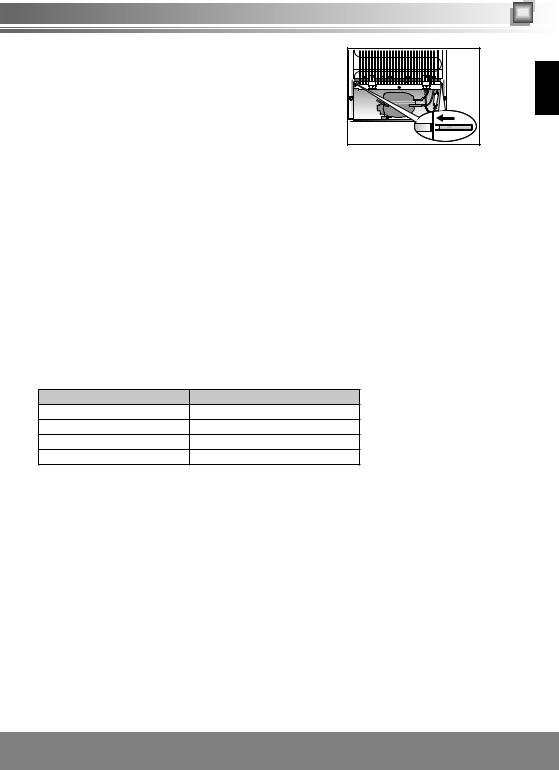
Installing the distance guides
The appliance is supplied with two distance guides which should be installed on the lower part of the housing to prevent from pushing the appliance too close to the wall.Appliance may also be installed without the spacers; however, this may increase power consumption.
Insert the distance guides into the holes circled in the figure. (The distance guides are included in the bag that contains the manual and other items.)
Cleaning
After installation, wipe the appliance clean with warm water.
Connecting the mains plug to the household mains socket
After the appliance is plugged, all symbols will appear for a moment, and then the startup values will appear as -18 °C on freezer setting indicator and 5 °C on fridge setting indicator.
All buttons on the control panel are touch-operated. (Only press to activate the button you want to operate.)
Notes:
•Cooling may take longer in the summer months or at other times when the room temperature is higher.
•If you need to unplug the refrigerator, wait at least 10 minutes before you plug it back in again. If not, you might damage the compressor.
•If you’re not going to use the refrigerator for a long time, unplug it from the mains.
Ambient room temperature
You’ll find your refrigerator’s climate classification on the rating plate in the left side of the fridge compartment. It shows the room temperature the appliance is designed to work in.
Climate classification |
Permitted ambient temperature |
|
SN |
(Extended Temperate) |
+10 °C to 32 °C |
N |
(Temperate) |
+16 °C to 32 °C |
ST |
(Subtropical) |
+16 °C to 38 °C |
T |
(Tropical) |
+16 °C to 43 °C |
For saving energy
1.Install the refrigerator in a dry, cool and well-ventilated room. (Please refer to Page 6 for dimensions and clearance.)
2.The combination of drawers and shelves that result in the largest in volume and the most efficient use of energy for the refrigerator.
•Remove the top and middle drawers of the freezer.
•Attach the drawers and shelves in the refrigerator to the positions illustrated on the section of “Parts” (P.8).
3.Do not over fill the refrigerator to allow the air to circulate.
4.Open the doors only when necessary and as briefly as possible.
5.Occasionally clean the ventilation openings at the bottom of the refrigerator with a vacuum cleaner, etc.
6.When setting to Super Freeze Mode, Flash Freeze Mode or Super Cool Mode, power consumption will be increased.
English
7
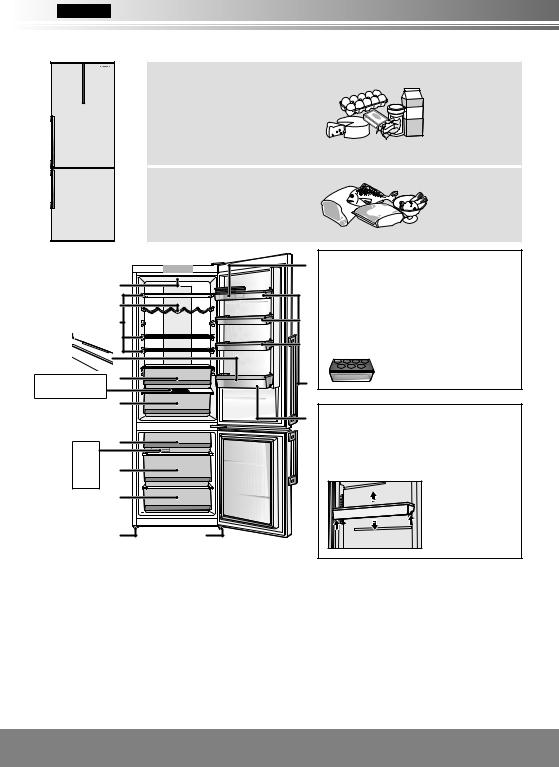
 Parts
Parts
The illustration below is based on model NR-BN34EX1, and may be slightly different to your refrigerator.
Fridge compartment |
|
|
The temperature can be set in a range |
Cooked food, drinks, |
|
eggs, cakes, dairy |
||
from 1 °C to 9 °C. |
products |
|
Freezer compartment |
|
|
The temperature can be set in a range |
Frozen meat, poultry, |
|
fish, |
||
from -24 °C to -16 °C. |
||
ice cream |
||
|
|
|
6 |
|
1 |
|
|
2 |
|
> |
3 |
|
p |
|
|
|
4 |
7 |
|
|
|
|
5 |
|
|
|
8 |
= |
9 |
|
|
|
|
|
: |
|
|
; |
|
|
< |
< |
•“Multibox” storage box 6 has a lid and offers a convenient way for storing food with a strong or pungent smell, e.g. ripened or blue-vein cheese, sausages, onions, butter etc.
•The lid can also be used as an egg or ice tray.
•If the lid is used as an egg tray, place it directly on the bottom of the door shelf and use the open lower part of the “Multibox” storage box to store food in smaller packagespate, jams, smaller tubes etc.
The height of shelves 7 can be adjusted to your preferences without having to take them out of the appliance. Pull the two levers on either side of the shelf towards you and move the shelf down. If you wish to set the shelf higher, you can do so without releasing the two levers.
1 LED lighting of fridge interior |
6 |
“Multibox” storage box |
; Bottom freeze drawer |
|
2 Bottle rack |
7 |
“FlexLift” height adjustable door shelf |
< Adjustable legs |
|
3 |
“Slide‘N’Store” Glass shelf |
8 Bottle shelf |
= Ice tray |
|
4 Chill case |
9 Upperfreezedrawer |
> Bottle stopper |
||
5 |
“Vitamin Safe” crisper |
: Middle freeze drawer |
p High fresh film cassette |
|
Note:
•You can change the positions where the Glass shelves and Door shelves are installed. Please use caution, however, because stored food and beverages could fall out when the door is opened and closed depending on the shelf positions.
•When opening the door, please take care to avoid collisions with people or objects in the vicinity.
8
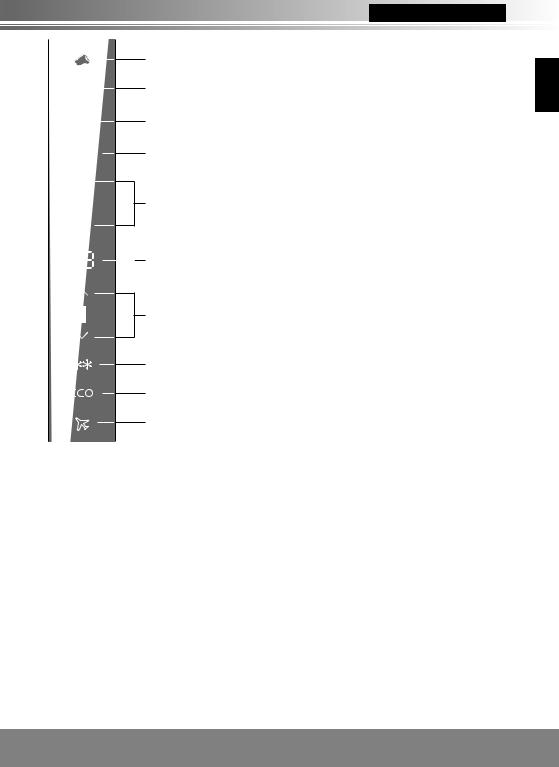
Control panel 
|
1 |
Vitamin Safe Mode button |
|
1 |
2 |
Alarm button/indicator and Child safety lock button |
|
|
|
• When the temperature inside is too high, the indicator flashes. |
|
2 |
|
• When the doors is open for a long time, the indicator flashes. |
|
|
3 |
Super Cool Mode button |
|
3 |
4 |
Fridge temperature display |
|
|
|
• During Child safety lock Mode, “LL” appears. |
|
4 |
|
• During Super Cool Mode, “SC” appears. |
|
5 |
Fridge temperature button (printed) |
||
|
|||
|
6 |
Freezer temperature display |
|
5 |
|
• During Super Freeze Mode, “SF” appears. |
|
|
• During Flash Freeze Mode, “FF” appears. |
||
|
|
• During Child safety lock Mode, “LL” appears. |
|
|
7 |
Freezer temperature button (printed) |
|
6 |
8 |
Super Freeze Mode/Flash Freeze Mode button |
|
|
9 |
ECO Mode button |
: Holiday Mode button
7
8
9
:
This illustration shows that all the displays and buttons are turned on.
Notes:
•This refrigerator uses a microprocessor to control the temperature. The temperature inside the refrigerator varies depending on such factors as changes in the room temperature, how frequently the doors are opened and closed, and how much food is stored inside and how it is stored.
•When ECO Mode or Holiday Mode is set, the indicator corresponding to the selected mode lights.
•Alarm indicator will flash and alarm will be heard at the same time.
•The anti-scratch protective film is pasted on the control panel.
•The settings may change if you touch a button when cleaning the control panel.
English
9
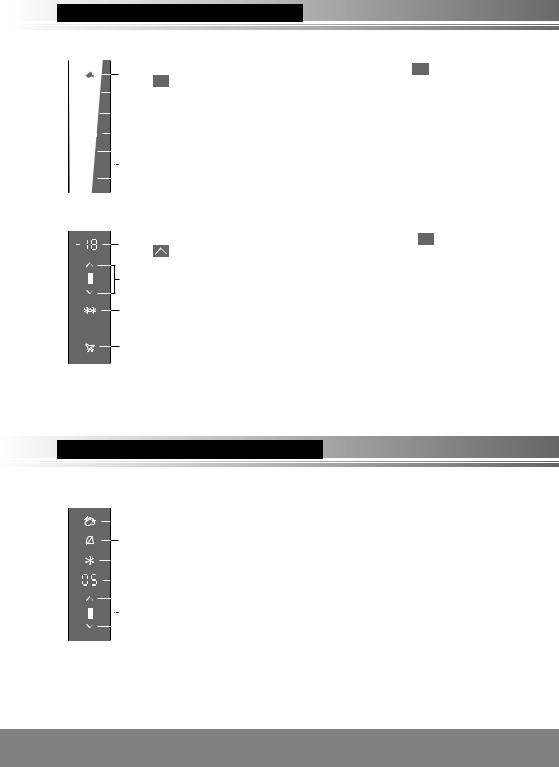
 Setting the temperature
Setting the temperature
Fridge compartment
1• To set the temperature in the fridge compartment use the keys 5:  lower temperature;
lower temperature;
 higher temperature. Touch the keys to turn the temperature display on.
higher temperature. Touch the keys to turn the temperature display on.
|
|
|
|
2 |
• Temperature in the fridge compartment can be set from +1 °C to +9 °C. |
||
|
|
|
|||||
|
|
|
|
3 |
• After one of the 5 keys is pressed, the most recent temperature setting will flash on the |
||
|
|
|
|
|
|
|
display 4. Use the 5 keys to set the desired temperature. |
|
|
|
|
4 |
Three seconds after the last key was pressed, the most recent temperature setting is stored |
||
|
|
|
|||||
|
|
|
|
|
|
|
for the fridge compartment. The keys turn off after approximately 30 seconds. |
|
|
5 |
Note: |
||||
|
|||||||
|
|||||||
|
|
|
|
|
|
|
• When Super Cool Mode, Flash Freeze Mode, ECO Mode or Holiday Mode ends or is |
cancelled, the unit returns to its previous settings.
Freezer compartment
6• To set the temperature in the freezer compartment use the keys 7:  lower temperature;
lower temperature;
higher temperature. Touch the keys to turn the temperature display on.
• Temperature in the freezer compartment can be set from -24 °C to -16 °C.
7 • After one of the 7 keys is pressed, the most recent temperature setting will flash on the
|
display 6. Use the 7 keys to set the desired temperature. Three seconds after the last key |
|
8 |
was pressed, the most recent temperature setting is stored for the freezer compartment. The |
|
keys turn off after approximately 30 seconds. |
||
|


 9 Note:
9 Note:
:• When Super Freeze Mode, Flash Freeze Mode, ECO Mode ends or is cancelled, the unit returns to its previous settings.
 Using the handy functions
Using the handy functions
Press a function operation button to turn the button on. The button turns off in approximately 30 seconds after the setting.
Vitamin Safe Mode |
|
||
1 |
• Setting this mode helps to protect the vitamin C and D contained in vegetables and fruit. The |
||
|
|
|
blue, green and white LED lights. |
2To activate the Vitamin Safe function, press the 1 key.
The 1 key lights up. With this function activated, appliance will operate with optimum settings.
|
|
|
|
3 |
Notes: |
|||
|
|
|
||||||
|
|
|
|
4 |
• |
During this mode: |
||
|
|
|
||||||
|
|
|
|
|
|
|
|
-By pressing the 1 key ,Vitamin Safe Mode will be cancelled. |
|
|
5 |
• |
Vitamin Safe Mode is valid in "Vitamin Safe" crisper. |
||||
|
||||||||
|
||||||||
|
|
|
|
|
|
|
|
|
10
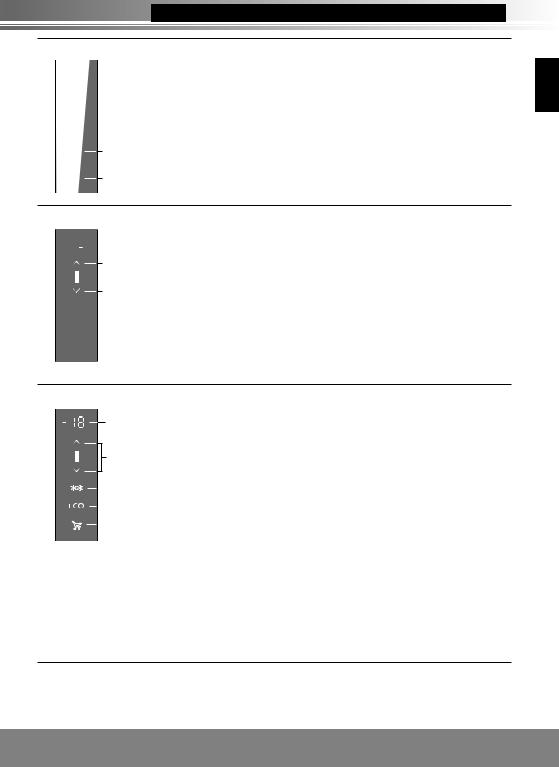
Using the handy functions (continued) 
Super Cool Mode

 1
1 
 2
2



 3
3 


 4
4
 5
5
•Use this setting after switching on the appliance for the first time, before cleaning, or before inserting a large amount of food.
Switching on Super Cool Mode function:
Press the 3 key. “SC” will appear on the display 4.
If the function is not deactivated manually, it will be deactivated automatically after approximately six hours. Fridge compartment temperature will return to the most recent setting.
Notes:
•During this mode:
-By pressing the 3 key, Super Cool Mode will be cancelled. ECO mode, Holiday Mode can be selected.
-If either of those functions is selected, Super Cool Mode will be cancelled. -The freezer temperature can be adjusted.
-Although the fridge temperature can also be adjusted, Super Cool Mode will be cancelled.
Super Freeze Mode




 6
6
 7
7




 8
8 

 9
9

 :
:
•Use this setting after switching on the appliance for the first time, before cleaning, or 24 hours before inserting a large amount of food.
Switching on the Super Freeze function:
Press the 8 key. “SF” will appear on the display 6.
If the Super Freeze Mode is not deactivated manually, it will be automatically switched off after approximately two days. Then the temperature of the freezer compartment returns to the most recently set value.
Notes:
•During this mode:
-By pressing the 8 key, Super Freeze Mode will be cancelled. ECO mode, Holiday Mode can be selected.
-If either of those functions is selected, Super Freeze Mode will be cancelled. -The fridge temperature can be adjusted.
-Although the freezer temperature can also be adjusted, Super Freeze Mode will be cancelled.
Flash Freeze Mode • In order to quickly freeze fresh food, use the Flash Freeze Mode function that is only active in the upper freeze drawer of the freezer compartment. It involves intensive blowing of cool air in
6that part of the appliance. Faster freezing will retain more vitamins, minerals, and nutrients in the food for a longer period of time.
Switching on the Flash freeze Mode function:
7Press the 8 key and hold it for at least three seconds. “FF” will appear on the display 6.
•With this setting, the compressor will operate continuously and the temperature in the freezer compartment will drop considerably.
|
8 |
• |
If the setting is not deactivated manually (by pressing the 8 key), it will be deactivated |
|
|||
|
9 |
|
automatically after 8 hours. Freezer compartment temperature will return to the most recent |
|
: |
|
setting. |
|
• |
Use this setting for freezing smaller amounts of food (up to two kilograms) in the upper freeze |
drawer. When freezing a large amount of food, the setting should be activated 12 hours before the food is placed in the freezer.
Notes:
•During this mode:
-By pressing the 8 key, Flash Freeze Mode will be cancelled. ECO mode, Holiday Mode can be selected.
-If either of those functions is selected, Flash Freeze Mode will be cancelled. -The fridge temperature can be adjusted.
-When the Super Cool Mode is activated, this mode cannot be selected.
-Although the freezer temperature can also be adjusted, Flash Freeze Mode will be cancelled.
English
11
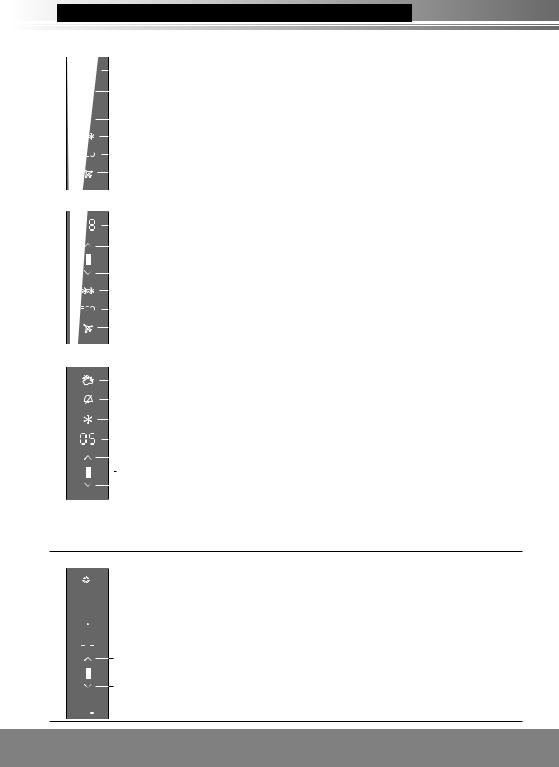
 Using the handy functions (continued)
Using the handy functions (continued)
ECO Mode |
• In this mode, the control unit operates the freezer and fridge economically. |
||||||
|
|
|
|
|
|
|
To activate the Eco Mode function, press the 9key. The 9key lights up. With this function activated, |
|
|
|
|
|
6 |
appliance will operate with optimum settings. |
|
|
|
|
|||||
|
|
|
|
|
|
|
Notes: |
|
|
|
|
|
|
7 |
• During this mode: |
|
|
|
|
-The temperature of the fridge and freezer cannot be adjusted. ECO Mode will be cancelled and |
|||
|
|
||||||
|
|
|
|
|
|
|
the selected temperature will be set. |
|
|
|
|
|
|
|
|
|
|
|
|
|
8 |
-Super Cool Mode, Super Freeze Mode or Flash Freeze Mode can be selected. |
|
|
|
|
|
|
|
9 |
If either mode is selected, ECO Mode will be cancelled and the selected mode will become |
|
|
|
|
|
active. |
||
|
|
|
|
||||
|
|
|
|
|
: |
-Holiday Mode can be selected. |
|
|
|
|
|
||||
|
|
|
|
|
|
|
|
|
|
|
-When this mode is ended, the fridge will resume operation with its previous settings. |
||||
|
|||||||
|
|
|
|
|
|
9 |
|
|
|
|
|
|
|
||
|
|
|
|
|
|
||
|
|
||||||
Holiday Mode |
If it is selected, ECO Mode will be cancelled and Holiday Mode will become active. |
||||||
• Set this mode when the fridge in not going to be used for a prolonged period such as during a |
|||||||
|
|
|
|
|
|
|
long vacation. |
6 |
• In this mode, the fridge temperature is automatically set to 12 °C. (Fridge temperature display |
||||||
|
|
|
|
|
|
|
turns off.) |
7 |
To activate the Holiday Mode function, press the : key. The : key lights up. With this function |
||||||
activated, appliance will operate with optimum settings. |
|||||||
|
|
|
|
|
|
|
Notes: |
8 |
• During this mode: |
||||||
|
|
|
|
|
|
|
-Before using this mode, empty out the fridge, and close door. |
|
|
: |
-The fridge temperature cannot be adjusted until this mode is cancelled. |
||||
|
|
|
|
|
|
|
-When the door is opened, alarm will be activated. |
Alarm Mode |
|
|
|
High temperature alarm: |
|||
|
|
|
|
|
|
• |
If the temperature inside the appliance is too high, acoustic alarm will be activated (intermittent |
|
|
|
|
|
1 |
|
tone) and the 2 key will flash. |
|
|
|
|
|
|
||
|
|
|
|
|
2 |
• Acknowledge and turn off the acoustic alarm by pressing the 2 key. |
|
|
|
|
|
|
• |
The acoustic alarm will be activated every 24 hours if the temperature in the appliance is not |
|
|
|
|
|
|
|
||
|
|
|
|
|
3 |
|
low enough and there is danger of food spoilage. |
|
|
|
|
|
|
||
|
|
|
|
|
4 |
|
The alarm will be switched off automatically as soon as the temperature in the freezer drops to |
|
|
|
|
|
|
a level that no longer presents spoilage hazard. |
|
|
|
|
|
|
|
||
|
|
|
|
|
|
• |
When the appliance is switched on for the first time, there is a 24-hour delay in temperature |
|
|
|
|
5 |
|
alarm operation since the appliance will not have reached the adequate temperature. |
|
|
|
|
|
||||
|
|
|
|
||||
|
|
|
|
|
|
|
Thus, unnecessary activation of alarm is prevented. |
Open refrigerator door alarm:
•If the refrigerator or freezer compartment door is open for more than two minutes, acoustic alarm will be activated and the 2 key will flash.
When the door is closed, the alarm will be deactivated. It can also be switched off by pressing the 2 key.
Child safety lock

 1
1 
 2
2



 3
3 


 4
4
 5
5



 6
6
Use this function if you do not wish to manually adjust the appliance settings.
To activate, press and hold the 2 key (for three seconds). “LL” will appear on the display 4 and 6, and alarms will sound.
This will lock all keys except 2.
To deactivate the safety lock, press the 2 key and hold it for three seconds.
Note:
•“LL” is not displayed while this function is activated. However, “LL” will appear in a second by pressing any key.
12
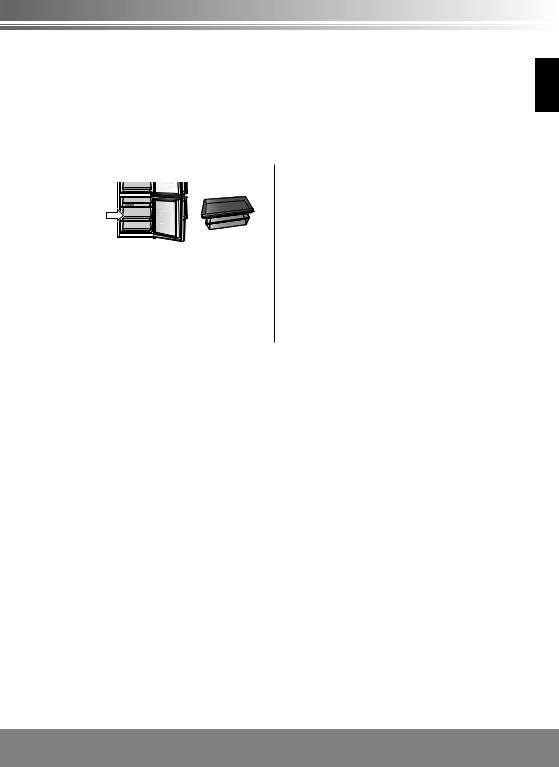
Humidity control of “Vitamin Safe” Crisper 
• The bin at the bottom of the refrigerator is intended for storing fruit and vegetables. It keeps humidity and prevents the food from drying out.
• Store the food in suitable packaging to prevent them from emitting or taking on odors.
• The humidity in the bin is automatically controlled.
English
Making ice cubes 
"Multibox"storage box (All models)
Water
“Multibox” storage box can make ice cubes and store them. To make ice cubes, fill the lid of the “Multibox” storage box with water and place it in the freeze drawer of the freezer. When ice cubes are ready, take out the box from the freezer drawer. Remove the lid from the box, and push each cavity of the lid from the back side. The ice cubes will pop out from the lid. Then, put the box back into its place.
Ice Tray
Water level line 
Open the freezer, pull out the freeze drawer and take out the ice tray. Fill water in the ice tray to the water level line and then place back the ice tray.
When ice cubes are ready, pull out the freeze drawer and take out the ice tray. Slightly twist the ice tray by holding its two sides, the ice cubes will drop from the ice tray. Then, put the ice tray back into its place.
When you pull the freeze drawer out, the ice tray and Multibox may slant, causing water to spill. Carefully pull out the freeze drawer.
Removing and attaching shelves 
Fridge
1 |
2 |
1 |
2 |
|
2 |
1 |
|
|
Glass shelves |
Chill case and |
Door shelves |
Bottle shelf |
|
|
|
High fresh film |
||||||||||||
|
To remove a shelf |
“Vitamin Safe” |
To remove a shelf, |
To remove a shelf |
|
|
|
cassette |
||||||||||||
|
from the refrigerator, |
crisper |
move the shelf to |
from the appliance, |
|
|
|
While pulling the |
||||||||||||
|
pull it out to the |
Pull out the case |
the highest position, |
lift it as far as it will |
|
|
|
handle, slide until the |
||||||||||||
|
point when it is |
as far as it will go. |
push the left and |
go and pull it out. |
|
|
|
tab is released, then |
||||||||||||
|
stopped by the |
Then, lift the front |
right levers up, and |
|
|
|
|
|
|
|
|
|
pull out the cassette. |
|||||||
|
guide. Then, lift it |
part and pull it out |
then pull the shelf |
|
|
|
|
|
|
|
|
|
Attach the cassette |
|||||||
|
slightly at the front |
completely. |
out. |
|
|
|
|
|
|
|
|
|
in reverse order of |
|||||||
|
part and pull it all |
|
|
|
|
|
|
|
|
|
|
|
the procedure above. |
|||||||
|
the way out. |
|
|
|
|
|
|
|
|
|
|
|
Refer to Parts in |
|||||||
|
|
|
|
|
|
|
|
|
|
|
|
|
Page 8. |
|||||||
Freezer |
|
|
|
|
|
|
|
|
|
|
|
|
|
|
|
|
|
|||
|
|
|
|
|
|
|
|
|
|
|
|
|
|
|
|
|
|
|
|
|
The drawers are protected against pulling out. To remove a drawer from |
|
|
|
|
|
|
|
|
|
|
|
|
|
|
|
|
||||
|
the appliance, open it, then lift the front part and pull it out. |
|
|
|
|
|
|
|
|
|
|
|
|
|
|
|
|
|
||
|
|
|
|
|
|
|
|
|
|
|
|
|
|
|
|
|
|
|||
|
|
|
|
|
|
|
|
|
|
|
|
|
|
|
|
|
|
|
|
|
|
|
|
|
|
|
|
|
|
|
|
|
|
|
|
|
|
|
|
|
|
|
|
|
|
|
|
|
|
|
|
|
|
|
|
|
|
|
|
|
|
|
|
|
|
|
|
|
|
|
|
|
|
|
|
|
|
|
|
|
|
|
|
13
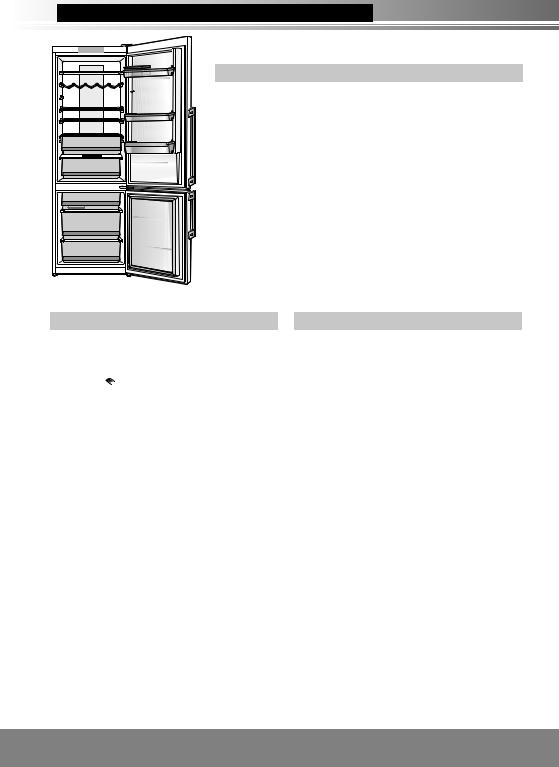
 Care and Cleaning instructions
Care and Cleaning instructions
Daily cleaning
Wipe regularly with a dry cloth.
Places to pay particular attention to:


 Door opening seal
Door opening seal
If the seal gets dirty and damaged, cold air is more likely to leak.
Bottle shelf
Wipe away any dirt and liquid before it builds up. |
Each year, unplug your refrigerator, remove the shelves and give them a
thorough clean.
Parts you can wash with water
Fridge |
Freezer |
● Glass shelves ● Door shelves ● Bottle shelf
● “Multibox” storage box ● Chill case
● “Vitamin Safe” crisper ● Bottle rack
● Bottle stopper

 ● High fresh film cassette
● High fresh film cassette
Note:
•Do not use abrasive cleaners such as Bicarbonate of Soda, as they can damage the plastic.
● Upper freeze drawer 

 ● Middle freeze drawer
● Middle freeze drawer  ● Bottom freeze drawer
● Bottom freeze drawer
● Ice Tray
Cleaning the high fresh film cassette
The high fresh film cassette is fixed with claws. Remove the cassette and wash it with water.After washing the cassette with water, drain it and wipe any remaining water drops before attaching. If stains are hard to remove, carefully wash the cassette with a mild kitchen detergent (neutral) and a soft cloth, and wash the detergent away with water.
Cleaning the control panel
The refrigerator’s control panel is made of delicate materials. To protect its surfaces, do not clean it with solvent based chemicals. Simply wipe it with a dry or slightly damp cloth.
Cleaning the outside of the refrigerator
Use a warm, damp, soft cloth to clean the outside of your refrigerator. For more stubborn marks, use a mild kitchen detergent and wipe away with a soft damp cloth. Remove any remaining surface water with a dry cloth.
Notes for cleaning
When cleaning inside or outside your refrigerator, do not use:
●alkaline detergents - they can crack plastic parts.
●grinding dust, soap powder, oil-based cleaners, hot water, brushes, acids, benzenes, solvents or alcohol-based
solutions - all can damage the refrigerator’s surfaces and plastic parts.
Make sure you wipe off any stains from edible oils, which can also damage plastic parts.
14
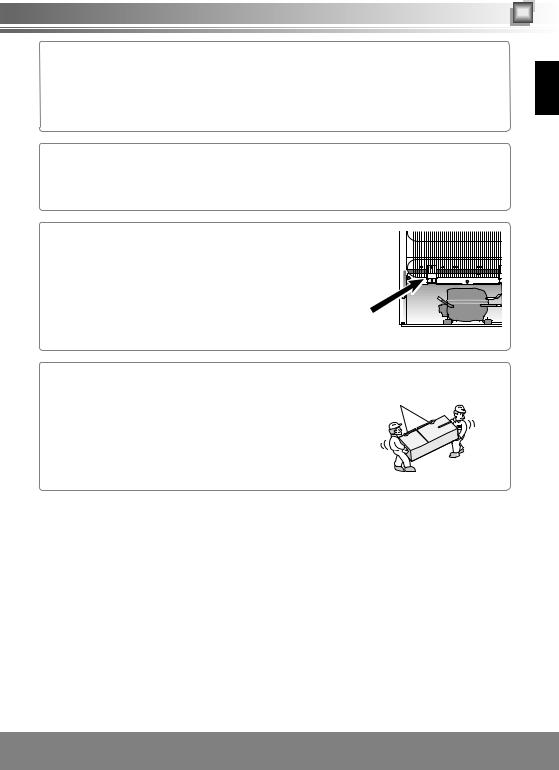
Maintenance check
●Is the mains lead damaged?
●Does the mains plug get hot?
●Is the mains plug firmly in the mains socket?
If the mains lead is damaged, please consult an authorized service centre. DO NOT attempt to replace these items yourself.
Extended disuse
If you’re not going to use the refrigerator for a long time, unplug it and clean the mains plug as described above. Then leave the doors open for 2-3 days. This lets the interior dry out properly, and prevents odour and the build up of mould. Do not switch the refrigerator on and off repeatedly. It will last longer if you leave it switched on during normal use.
Before moving or transporting your refrigerator |
|
Remove all items. |
|
Unplug it. |
|
Raise the adjustable leg. |
|
Pull, or ‘walk’ the refrigerator towards you. |
|
Put a cloth on the left corner of the evaporation pan. Slant the |
|
refrigerator for the cloth to absorb water. (Be sure there is no |
Evaporation |
remaining water.) |
(Lower back of the refrigerator) |
Moving and transporting your refrigerator
At least two people are needed to carry the refrigerator safely.Tighten the adjustable legs.
Hold the adjustable legs at one end, and corners at the other, as shown.
Note:
•Do not carry the refrigerator by holding its doors.
Always transport the refrigerator in its normal upright position.
Secure the doors with adhesive tape
English
15

 FAQs
FAQs
If you feel that the refrigerator is not working properly, check out the following points first.
If the trouble persists, disconnect the mains plug and contact your dealer or an authorized service centre.
General
You hear unusual sounds from the |
• |
Has the refrigerator been installed on a sturdy and level floor? |
refrigerator. |
• |
Have sufficient clearances been provided around the refrigerator? |
|
• |
Is anything vibrating on the top of the refrigerator? |
|
• |
It’s normal to hear some noises when the refrigerator starts or stops operation. |
You hear a sound after the |
• |
This is normal, and is often caused by refrigerant flowing back to the |
compressor has shut down. |
|
compressor. |
You hear a sound after you have |
• |
This is normal, and is due to the difference in air pressure between the inside |
opened or closed the door. |
|
and outside of the refrigerator. |
You hear the sound of air or water |
• |
This is caused by refrigerant flowing the internal pipework. |
flowing after you have opened |
|
|
the door. |
|
|
You hear a continuous whining |
• |
This sound is heard while the fan for circulating the cold air is operating. |
sound. |
• Has the food been packed too tightly together or is the room temperature high? |
|
|
|
In cases like these, the fan for circulating the cold air runs at high speed so it |
|
|
makes a loud noise. |
The compressor is quite loud.
•Has the food been packed too tightly together or is the room temperature high? In cases like these, the compressor runs hard so it’s normal for the compressor to be louder.
The compressor has been running • When the mains plug has been connected for the first time, the compressor for a long time. runs longer than usual in order to cool down the inside of the refrigerator until the set temperatures are reached.
•Has Super Freeze Mode or Super Cool Mode been set?
•Have the doors been opened and closed frequently? Are the doors completely shut?
•Have the food items been packed too tightly together or is the room temperature high?
•When many food items are placed in the refrigerator at one time, the compressor will need to run for a longer period.
Condensation forms on the |
• Condensation may form when the humidity in the room is high and is normal. |
|
outside of the refrigerator. |
|
Wipe it off using a dry cloth. |
The outside of the refrigerator |
• |
After the power of the refrigerator is turned on, the refrigerator may become |
feels hot to the touch. |
|
warm until the interior of the compartment is sufficiently cooled down. The |
|
|
refrigerator may become warm even after the compartments have been cooled |
|
|
down. This is due to the operation of the heat radiation pipe equipped on the |
|
|
refrigerator for the purpose of preventing condensation, and is not malfunction. |
The controls on the control panel |
• |
Is the power to the refrigerator on? |
cannot be operated. |
|
|
The alarm sounds. |
• |
The fridge door has been left ajar. Close the doors. |
16
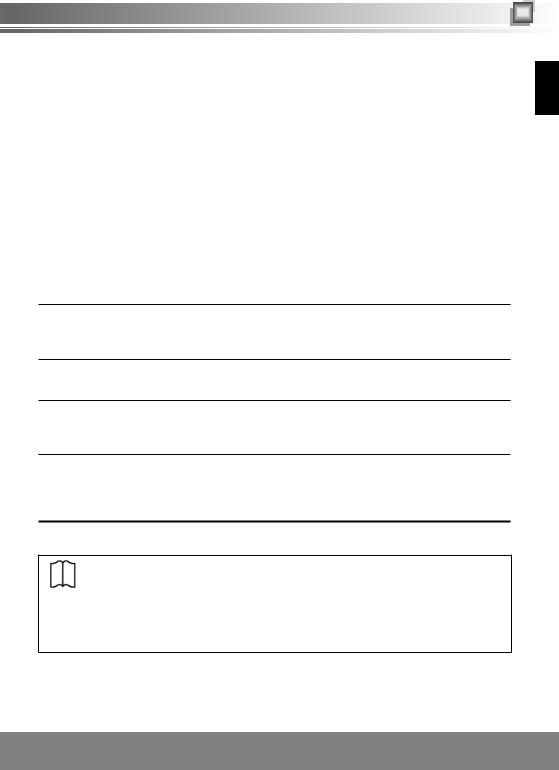
Fridge and freezer
The fridge is not chilling (and the |
• |
Is the power to the refrigerator on? |
freezer is not freezing). |
|
|
The fridge is not chilling (and |
• |
Is the set temperature too high? |
the freezer is not freezing) |
• |
Is the refrigerator exposed to direct sunlight or positioned near a heating |
satisfactorily. |
|
appliance? |
|
• |
Have sufficient clearances been provided around the refrigerator? |
|
• Have the food items been packed too tightly together or is the room |
|
|
|
temperature high? |
|
• Have the doors been opened and closed frequently? |
|
|
|
Are the doors completely shut? |
|
• Has Holiday Mode been set? |
|
|
• |
When warm food is put inside the refrigerator, the temperature will rise |
|
|
temporarily. |
|
• During the cold season or when the room temperature is low, it may feel as if |
|
|
|
the refrigerator is not chilling. |
There is a difference between |
• |
When warm food is put inside the refrigerator, the temperature will rise |
the set temperature and actual |
|
temporarily. |
temperature.
Food in the fridge freezes. • Is the set temperature for the fridge too low?
•Has the food been placed at the back of the fridge?
The area near the back wall is where the temperatures are coldest so avoid placing food which may freeze easily here.
Condensation forms in the fridge • Condensation may form when the door has been opened and closed frequently and drawers. or when it has not been shut completely, or when the room humidity is high.
Wipe off the condensation using a dry cloth.
It is hard to open the freezer door. • The door is sometimes difficult to open just after it has been closed.
•The difference in air pressure between the inside and outside of the freezer may sometimes make it hard to open the freezer door. Wait a few moments, and then try opening the door.
It smells inside the refrigerator. • Were any food items with strong odours sealed before they were placed in the fridge?
Place the items inside a sealed container and store them.
•Odours may stick to the surfaces inside the refrigerator. Wipe the surfaces using a soft cloth which has been dipped in lukewarm water.
This symbol is used to refer users to the instructions or leaflets for relevant information.
This refrigerator incorporates a filter, which is considered a biocidal product.
The filter itself incorporates a substance containing silver ions which deactivates bacteria in the air inside the refrigerator and inhibits bacterial growth.
Active substance: Silver sodium hydrogen zirconium phosphate
English
17
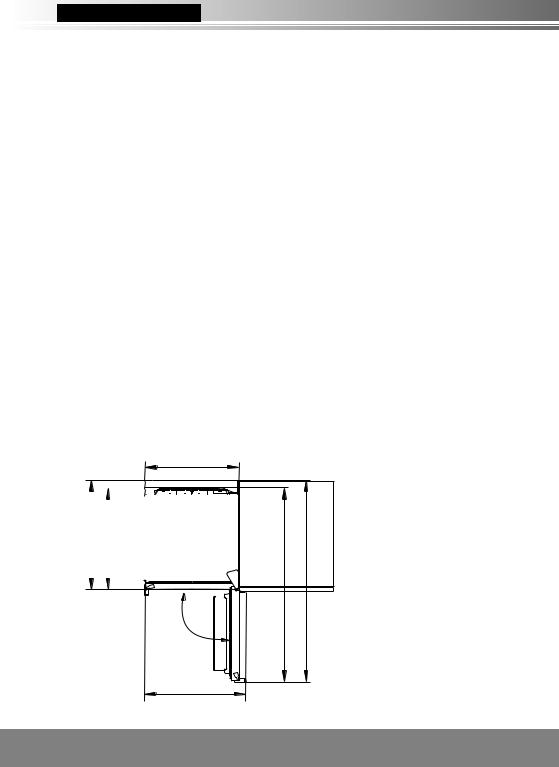
 Specifications
Specifications
Product fiche (EU Regulation 1060/2010) |
|
|
SUPPLIER'S NAME |
Panasonic |
|
MODEL |
NR-BN34EX1 |
|
CATEGORY |
7 (Refrigerator-Freezer) |
|
ENERGY EFFICIENCY CLASS |
A+++ |
|
ANNUAL ENERGY CONSUMPTION |
172 kWh/year*1 |
|
NET FRIDGE VOLUME |
238 L |
|
NET CHILL VOLUME |
16 L |
|
NET FREEZER VOLUME |
80 L |
|
STAR RATING OF THE FREEZER |
Four-star |
|
'FROST FREE' COMPARTMENTS |
Fridge: No-frost / Freezer: No-frost |
|
TEMPERATURE RISE TIME |
18 hours |
|
FREEZING CAPACITY |
12 kg/24 h |
|
CLIMATE CLASS |
SN-T*2 |
|
AIRBORNEACOUSTICAL NOISE EMISSIONS |
41 dB |
|
Other Information |
|
|
TOTAL GROSS VOLUME |
363 L |
|
TOTAL NET VOLUME |
334 L |
|
OUTSIDE DIMENSIONS |
600 mm x 633 mm x 2000 mm |
|
WIDTH × DEPTH × HEIGHT |
||
|
||
NET WEIGHT |
76 kg |
|
RATED VOLTAGE |
220 V - 240 V |
|
RATED FREQUENCY |
50 Hz |
|
REFRIGERANT/CHARGE |
R600a/45 g |
|
BLOWINGAGENT |
Cyclo-Pentane |
Notes:
*1
*2
The energy consumption per year is based on the standard test results for 24 hours in accordance with EN153. Actual energy consumption vary depending on how the appliance is used and where it is located.
The energy consumption when in use may vary depending on where the unit is installed, the temperature setting of each of the compartments, the ambient temperature and humidity, how often the doors are opened/closed, the volume and temperature of the food stuffs and how the appliance is used.
Permitted ambient temperature: 10 °C to 43 °C
When the doors are completely open
600 mm
677 mm |
|
|
|
|
|
|
|
|
|
|
|
|
|
|
|
633 mm |
|
|
|
|
|
|
|
|
|
|
|
|
|
||
|
|
|
|
|
|
|
|
|
|
|
|
|
|
|
|
|
|
|
|
|
|
|
|
|
|
|
|
|
|
|
|
|
|
|
|
|
|
|
|
|
|
|
|
|
|
|
|
|
|
|
|
|
|
|
|
|
|
|
|
|
|
|
|
|
|
|
|
|
|
|
|
|
|
|
|
|
|
|
|
1203 mm |
1247 mm |
90°
632.5 mm
18
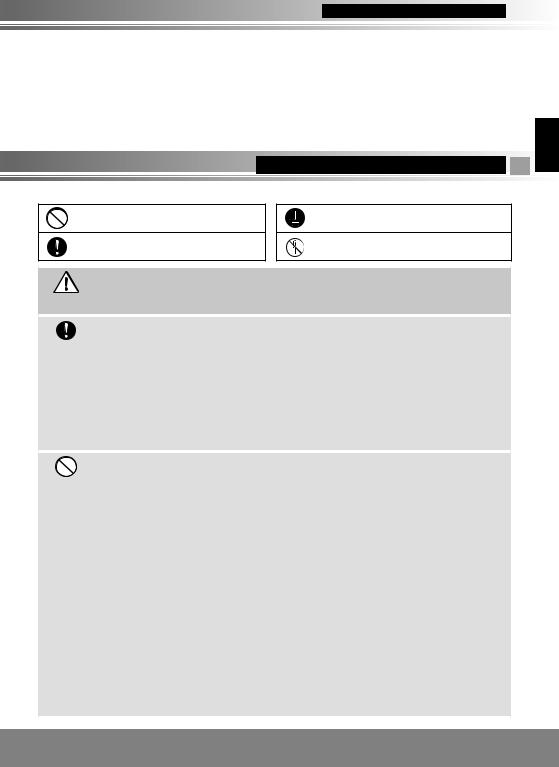
Inhaltsverzeichnis 
Sicherheitsanweisungen |
19 |
Feuchtigkeitskontrolle des Gemüsefachs |
|
Hinweise zur Entsorgung |
22 |
“Vitamin Safe” |
30 |
Montage |
23 |
Produktion von Eiswürfeln |
30 |
Schematische Ansicht |
25 |
Entfernen und Anbringen von Ablagen |
30 |
Display und Bedienfeld |
26 |
Pflegeund Reinigungshinweise |
31 |
Einstellen der Temperatur |
27 |
Fragen und Antworten |
33 |
Verwendung der Zusatzfunktionen |
27 |
Technische Daten |
35 |
Sicherheitsanweisungen
Deutsch
Bedeutung der Symbole:
Bitte nicht tun
Unbedingt tun
Zeigt an, dass das Gerät zur Verhütung von Stromschlägen geerdet werden muss
Nicht zerlegen
Weist auf Gefahr von Tod oder ernsthaften Verletzungen WARNUNG hin.
Dieses Gerät kann von Kindern ab 8 Jahren sowie von Personen mit
eingeschränkten körperlichen, sensorischen oder geistigen Fähigkeiten oder Unerfahrenheit und Unkenntnis des Geräts benutzt werden, wenn sie unterAufsicht oderAnleitung zur Verwendung des Geräts auf sichere Art stehen und die damit verbundenen Gefahren verstehen. Kinder dürfen nicht mit dem Gerät spielen. Die Reinigung und Benutzerwartung sollten nicht von Kindern ohneAufsicht durchgeführt werden.
Keine explosionsfähigen Substanzen wie etwa mit entzündlichem Treibmittel gefüllte Sprühdosen in diesem Gerät aufbewahren.
•Brennbare Substanzen, wie Benzol, Verdünner,Alkohol, Ether und Flüssiggas (LPG), können Explosionen verursachen.
Verwenden Sie keine Mehrfach-Steckdosenadapter, und schließen Sie nicht mehrere Geräte an denselben Steckdosenadapter an.
• Dies kann Überhitzen, Brand oder Kurzschluss verursachen.
Das Netzkabel nicht einklemmen, verknoten oder knicken, und auch keine schweren Gegenstände darauf stellen.
•Dies erhöht die Brandoder Stromschlaggefahr. Falls das Netzkabel oder der Netzstecker des Geräts beschädigt wird, muss das Teil vom Hersteller, dem Kundendienstvertreter oder einer ähnlich qualifizierten Person ausgewechselt werden, um Gefahren zu verhüten.
Den Kühlschrank nicht durch Ziehen am Netzkabel vom Stromnetz trennen.
• Dies kann eine Beschädigung des Netzkabels verursachen. Stets den Stecker fassen und kräftig von der Steckdose abziehen.
Keine Wasserbehälter auf den Kühlschrank stellen.
• Wasser kann die Isolierung von Elektroteilen beschädigen und einen Kurzschluss, Brand oder elektrischen Schlag verursachen.
Keine brennbaren Gase in der Nähe des Kühlschranks versprühen.
• Dies kann eine Explosion oder einen Brand verursachen.
Kein Wasser auf oder in den Kühlschrank sprühen.
• Dies kann einen Brand oder elektrischen Schlag verursachen.
19
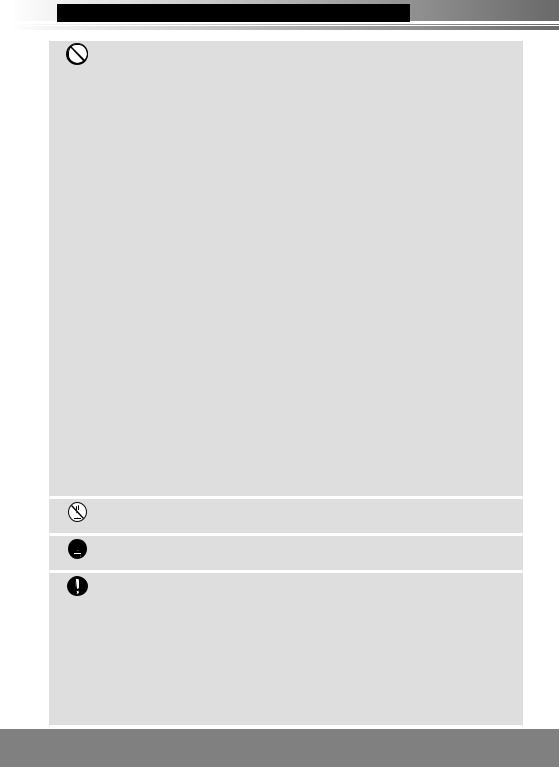
 Sicherheitsanweisungen (Fortsetzung)
Sicherheitsanweisungen (Fortsetzung)
Den Netzstecker nicht mit nassen Händen anfassen.
• Dies kann einen elektrischen Schlag verursachen.
Installieren Sie den Kühlschrank nicht an einem feuchten Ort oder einem Ort, wo er mit Wasser in Berührung kommen kann.
• Eine verschlechterte Isolierung von Elektroteilen kann einen Kurzschluss, elektrischen Schlag oder Brand verursachen.
Keine Arzneimittel oder andere temperaturempfindliche Produkte im Kühlschrank aufbewahren.
• Sie sollten keine Produkte im Kühlschrank lagern, die strenge Temperaturkontrolle erfordern.
Lassen Sie Kinder nicht auf die Kühlschranktür klettern, damit schwingen oder sich daran hängen.
• Dies kann ernsthafte Verletzungen verursachen und den Kühlschrank beschädigen.
Den Kühlschrank nicht in Gegenwart von explosiven Dämpfen oder brennbaren Gasen betreiben.
• Dies kann eine Explosion oder einen Brand verursachen.
Kein Benzin oder andere brennbare Flüssigkeiten und Dämpfe im Kühlschrank lagern oder in der Nähe des Geräts benutzen.
• Dies kann eine Explosion oder einen Brand verursachen.
-WARNUNG: Keine mechanischen Vorrichtungen oder andere Mittel außer den vom Hersteller empfohlenen verwenden, um den Abtauvorgang zu beschleunigen.
•Dies kann eine Beschädigung der Innenteile des Kühlschranks verursachen oder zu einer Explosion führen.
-WARNUNG: Keine Elektrogeräte außer den vom Hersteller empfohlenen in den Lebensmittelfächern des Geräts benutzen.
• Dies kann eine Explosion oder einen Brand verursachen.
-WARNUNG: Achten Sie darauf, dass der Kältemittelkreis nicht beschädigt wird.
• Dies kann eine Explosion oder einen Brand verursachen.
-WARNUNG: Öffnen Sie nicht die Abdeckung der LED-Leuchte im Inneren des Kühlschranks.
•EsbestehtStromschlaggefahr.WenndieLED-Leuchtenichtkorrektarbeitet, musssievomHersteller,demKundendienstvertreterodereinerähnlich qualifiziertenPersonausgewechseltwerden,umGefahrenzuverhüten.
Versuchen Sie nicht, den Kühlschrank selbst zu zerlegen, zu reparieren oder zu modifizieren.
•Sie könnten sich selbst oder andere mit Verbrennungen oder elektrischen Schlägen verletzen oder den Kühlschrank beschädigen. Falls Ihr Gerät Änderungen oder Reparaturen benötigt, konsultieren Sie bitte ein autorisiertes Kundenzentrum.
Vergewissern Sie sich, dass der Kühlschrank an eine geerdete Netzsteckdose angeschlossen ist. NICHT an eine nicht geerdete Netzsteckdose anschließen.
• Ein Kurzschluss kann einen elektrischen Schlag verursachen.
Sicherstellen, dass Netzkabel und Netzstecker nicht zerquetscht oder beschädigt werden.
•Ein beschädigter Netzstecker bzw. ein beschädigtes Netzkabel kann einen Kurzschluss, Brand oder elektrischen Schlag verursachen.
•Falls das Netzkabel beschädigt wird, muss es vom Hersteller, dem Kundendienstvertreter oder einer ähnlich qualifizierten Person ausgewechselt werden, um Gefahren zu verhüten.
•Versuchen sie nicht, das Kabel selbst auszuwechseln.
20
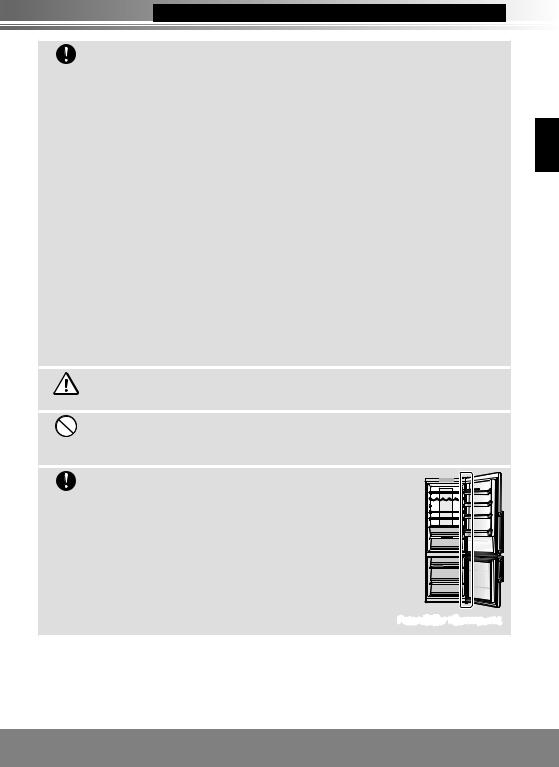
Sicherheitsanweisungen (Fortsetzung) 
Die Steckerstifte vor dem Anschließen an die Stromversorgung von Schmutz oder Staub säubern.
• Staubablagerungen auf dem Stecker können, besonders bei feuchten Bedingungen, einen Isolationsausfall verursachen. Dies kann zu einem Kurzschluss, Brand oder elektrischen Schlag führen. Ziehen Sie das Netzkabel ab, und wischen Sie es mit einem trockenen Tuch ab. Verwenden Sie keinesfalls ein nasses oder feuchtes Tuch.
Das Gerät so an die Steckdose anschließen, dass einwandfreier Anschluss gewährleistet ist.
• Ein lockerer Netzstecker kann einen Brand oder elektrischen Schlag verursachen.
Den Kühlschrank in gut belüfteter Umgebung installieren.
•Je mehr Kältemittel in einem Gerät vorhanden ist, desto größer sollte derAufstellungsraum sein. Sollte Kältemittel auslaufen, wenn sich das Gerät in einem kleinen Raum befindet, ist die Entstehung von brennbaren Gasen wahrscheinlicher. Dies kann einen Brand oder eine Explosion verursachen.Als Richtlinie wird für jeweils 8 g Kältemittel mindestens 1 m³ Raum benötigt. Das Datenschild im Inneren des Geräts gibt an, wie viel Kältemittel Ihr Kühlschrank enthält.
Das im Kühlschrank verwendete Kältemittel (R600a) und die im Isoliermaterial (Cyclopentan) enthaltenen Gase sind brennbar. Sie erfordern außerdem spezielle Entsorgungsverfahren.
•Vergewissern Sie sich vor der Entsorgung des Geräts, dass keines der Rohre auf der Rückseite beschädigt ist. Kältemitteloder Gaslecks können einen Brand oder eine Explosion verursachen.
Vor der Reinigung und Wartung den Netzstecker des Kühlschranks abziehen.
• Nichtbeachtung kann zu einem elektrischen Schlag führen.
Falls Sie einen Brandgeruch feststellen oder Rauch aus dem Kühlschrank kommen sehen, ziehen Sie sofort das Netzkabel ab, und konsultieren Sie bitte ein autorisiertes Kundenzentrum.
• Nichtbeachtung kann zu Feuer oder einem elektrischen Schlag führen.
-WARNUNG: Halten Sie die Lüftungsöffnungen im Gerätegehäuse bzw. in der Einbaustruktur frei von Hindernissen.
•Nichtbeachtung kann zu Feuer oder Explosion führen dasich das Kältemittel nicht verteilen kann, wenn es ausläuft.
ACHTUNG Weist auf die Gefahr von Verletzungen oder Sachschäden hin.
Keine Flaschen oder Behälter aus Glas in den Gefrierraum legen.
• Wenn der Inhalt gefriert, kann das Glas brechen und Verletzungen verursachen.
Berühren Sie die Innenwände des Gefrierraums oder die eingelagerten Waren nicht mit nassen Händen.
• Ihre Haut kann an der Innenwand des Gefrierraums oder den eingelagerten Waren festfrieren.
Vermeiden Sie bei einem Stromausfall häufiges Öffnen des Kühlschranks oder das
Einlagern nicht gekühlter Lebensmittel.
• Dies kann zu einemAnstieg der Temperatur im Kühlschrank führen und die Hygiene beeinträchtigen.
Achten Sie auch auf den Spalt zwischen der Kühlraumund Gefrierraumtür, besonders, wenn beide gleichzeitig offen sind.
• Dies kann Verletzungen verursachen.
Achten Sie beim Öffnen des Kühlschranks darauf, dass Sie Ihre Finger nicht an den “Klemmpunkt” – Bereichen einklemmen. Seien Sie besonders vorsichtig, wenn Sie die Kühlraumtür öffnen, um den potenziellen Klemmpunkt zwischen den Kühlraumund den Gefrierraumtüren zu vermeiden.
• Dies kann Verletzungen verursachen.
Potenzieller Klemmpunkt
Deutsch
21
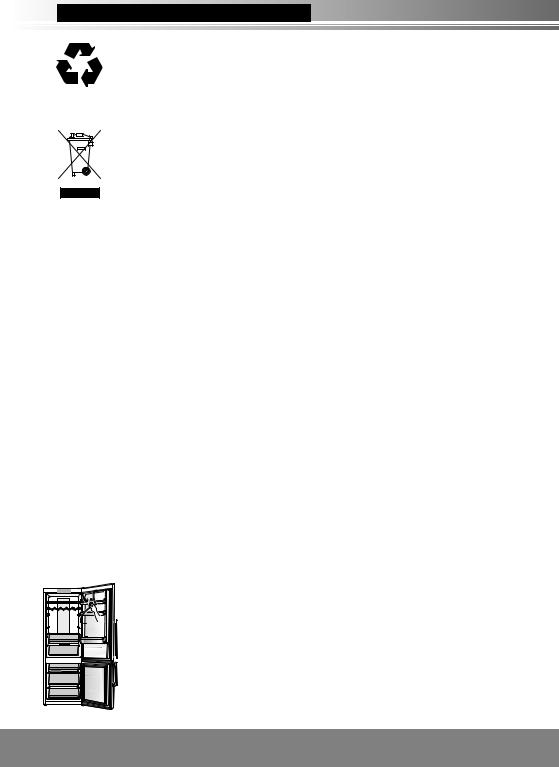
 Hinweise zur Entsorgung
Hinweise zur Entsorgung
Entsorgung von Verpackungsmaterial
Stellen Sie sicher, dass alle Verpackungsmaterialien wie Kartons, Plastiktüten, Klebeband und Polystyrol unmittelbar nach demAuspacken des Kühlschrankes sicher entsorgt werden und außerhalb der Reichweite von Babys und Kleinkindern sind. Kinder sollten niemals mit diesen Teilen spielen. Erstickungsgefahr!
Alle eingesetzten Materialien sind umweltverträglich und wieder verwertbar. Bitte helfen Sie mit: Entsorgen Sie die Verpackung umweltgerecht. Über aktuelle Entsorgungswege informieren Sie sich bitte bei Ihrem Fachhändler oder der Gemeindeverwaltung.
Entsorgung von Altgeräten
Nur für die Europäische Union und Länder mit Recyclingsystemen
Dieses Symbol, auf den Produkten, der Verpackung und/oder den Begleitdokumenten, bedeutet, dass gebrauchte elektrische und elektronische Produkte nicht in den allgemeinen Hausmüll gegeben werden dürfen.
Bitte führen Sie alte Produkte zur Behandlung,Aufarbeitung bzw. zum Recycling gemäß den gesetzlichen Bestimmungen den zuständigen Sammelpunkten zu.
IndemSiedieseProdukteordnungsgemäßentsorgen,helfenSiedabei, wertvolleRessourcenzuschützenundeventuellenegativeAuswirkungen aufdiemenschlicheGesundheitunddieUmweltzuvermeiden.
Für mehr Informationen zu Sammlung und Recycling, wenden
Sie sich bitte an Ihren örtlichenAbfallentsorgungsdienstleister.
Gemäß Landesvorschriften könnenwegen nicht ordnungsgemäßer
Entsorgung diesesAbfalls Strafgelder verhängt werden.
Für geschäftliche Benutzer in der europäischen Union
WeitereInformationenzurEntsorgungvonelektrischenundelektronischen
AltgerätenwendenSiesichanIhrenHändleroderZulieferer.
Informationen zur Entsorgung in Ländern außerhalb der europäischen Union
Dieses Symbol gilt nur in der europäischen Union. Informationen zur ordnungsgemäßen Entsorgung dieses Produkts erhalten Sie von Ihren lokalen Behörden oder Ihrem Händler.
Bevor Sie Ihr Altgerät entsorgen
Bitte befolgen Sie entweder die Entsorgungsanweisungen desAltgeräte-Herstellers oder die örtlichen Entsorgungsvorschriften für das Gerät. Sind diese nicht verfügbar, folgen Sie bitte den drei


 nachstehendenAnweisungsschritten.
nachstehendenAnweisungsschritten.
1. Den Netzstecker von der Steckdose abziehen.
2. Das Netzkabel abschneiden und mit noch angebrachtem Netzstecker sicher entsorgen.


 3. Vergewissern Sie sich, dass das Altgerät außer Reichweite von Kleinkindern ist, bis es abgeholt
3. Vergewissern Sie sich, dass das Altgerät außer Reichweite von Kleinkindern ist, bis es abgeholt
oder zu einem Recycling-Center gebracht wird.
● Entfernen Sie sämtliches Dichtungsmaterial von der Tür, und lassen Sie alle Regale und
Schubladen eingesetzt.
Dies soll verhindern, dass Kinder hineinklettern und eingeschlossen werden.
22
